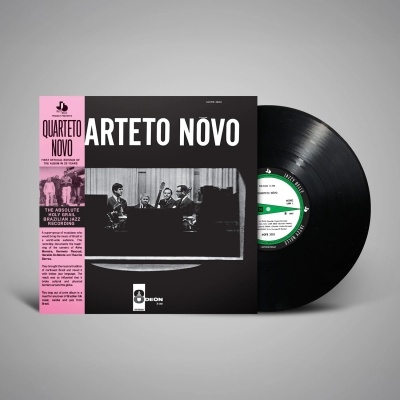ブラジリアン・ジャズの聖杯。25年ぶり待望のリイシュー!
ブラジリアン・ジャズやサンバ、フォーク愛好家必聴の1枚。1967年に結成されたブラジルの短命カルテットQuarteto Novo唯一のアルバムが初めて再発!
1967年に唯一のアルバムをリリースし、ブラジル音楽に大きな影響を与えた、ブラジリアン・ジャズの伝説的なグループQuarteto Novo。ブラジル北東部の伝統音楽、ビバップ・ジャズ、フォークを融合させた有機的なサウンドが特徴で、メンバーには若き日のAirto MoreiraやHermeto Pascoalなど、後に大成功を収めるアーティストたちが名を連ねています。ブラジル音楽史上で非常に影響力のある作品として知られいる今作が、25年ぶり初めてリイシュー。ブラジリアン・ジャズやサンバ、フォーク愛好家の必須の一枚です。
発売・販売元 提供資料(2025/01/06)
The sole album by the legendary Quarteto Novo was released by the Odeon label in 1967 and was accorded various coveted Brazilian artistic prizes, including the Trofeu Roquette Pinto and the Trofeu Imprensa. The band was made up of four now legendary Brazilian musicians: percussionist Airto Moreira; bassist, guitarist, and violinist Theo de Barros; guitarist, violinist, violist, and sometimes banjo player Heraldo do Monte (these three musicians all being members of the previous Trio Novo); and later arrival Hermeto Pascoal. Coming from the northeastern part of the nation, all of these men were intimately familiar with baiao music, the danceable rhythmic style comprised of a syncopated 2/4 time signature that could be played on the double-skinned zabumba drum and harmonic and melodic structures written around a Lydian flat seventh scale; it is derived from the tuning of the pifano flute, which has a raised fourth and flattened seventh. The chord structure is based on a dominant seventh. And while the style is not well-known outside Brazil, it nonetheless influenced a host of popular songwriters in America, England, and Europe, who scored hits with tunes utilizing the style's elements. (A couple of examples are the Burt Bacharach tune "Do You Know the Way to San Jose?" and "Save the Last Dance for Me," written by Doc Pomus and Mort Schulman and recorded by the Drifters.) Quarteto Novo -- and their patron and songwriting collaborator Geraldo Vandre -- had a deep, some would say obsessional, interest in American bebop; combine them and you have something very special indeed. Though in many ways, these eight songs sound somewhat quaint to undisciplined in the 21st century, the opposite is actually quite true. This meld of styles and the deep interest in subtle yet innovative rhythmic interplay, counterpoint, and taut song structures are to this day quite revolutionary.
The soulfulness at the heart of this music is a far cry from the breeziness of bossa nova, and there are no lyrics. Instead, on tunes like "Fica Mal com Deus," a 12-string guitar, a nylon-string guitar, and the pifano flute of Pascoal all enter in a head line like a bop composition. Within a chorus, the flute moves to a different melody, guitars accent two different parts of the rhythm, and Airto allows timekeeping and rhythmic invention to flow toward the melody instead of framing its outside. The listener is completely caught up in the joy and drama of the tune -- this also goes for the much more intricate and haunting "Canto Geral," which begins much more slowly but quickly weaves a pair of melodic intricacies together and frames them with a samba feel, which is stretched and cast off as three voices wordlessly create a third melody in the middle as a bridge, followed by a minor seventh interlude that is utterly forlorn before the pastoral open country feel returns. Amazing! The set closes with the popping "Vim de Sant'Ana," where piano, double bass, nylon-string guitars, and Airto's percussion magic are woven inseparably with a contrapuntal Wes Montgomery swinging soul-styled melody. Over its five minutes the track changes considerably, moving from one mode to another with seamless transitions until the listener is left breathless by its end. This record is difficult to find at times, and keeps getting reissued on CD in small batches. Look for it. One can hear so many things in this music that deserve a place on the sacred shelf. One can think of producers like Creed Taylor and his original idea for CTI and know he heard this music; one can hear the very foundation of Egberto Gismonti's music inside this record; and it can also be credited with much of the killer '70s jazz and Brazilian fusions that occurred on records by everyone from Joe Farrell and Chick Corea to Gary Burton and Freddie Hubbard. And then there are those brilliant albums by Airto, Dom Um Romao, Flora Purim, and so many others that came directly from the sounds displayed here to be continued...
Rovi
アイアート・モレイラ、エルメート・パスコアールが在籍していた伝説的クァルテットの67年作が遂にCD化!! スリリングなジャズのグルーヴと北東部のリズムを巧みに採り入れた流麗なショーロの旋律には、MPBの礎となるような斬新なアイデアがぎっしり。ただ驚愕するばかりの一枚だ。ボーナス・トラックとして2曲のシングルが収録されており、なかでもエドゥ・ロボ“Ponteio”のカヴァーが素晴らしい。
bounce (C)長屋美保
タワーレコード(2002年11月号掲載 (P100))



